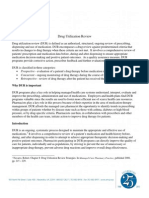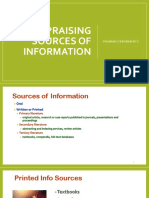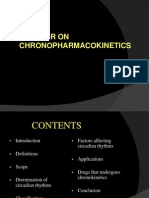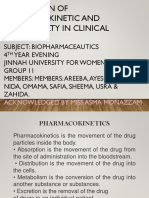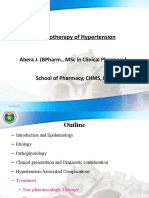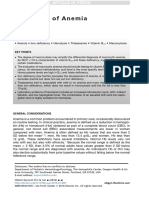100%(2)100% found this document useful (2 votes)
131 viewsGenetic Polymorphism in Drug Metabolism
Genetic Polymorphism in Drug Metabolism
Uploaded by
Mounika16 PedamalluGenetic polymorphisms in drug-metabolizing enzymes can impact drug response. Variations in genes like CYP2D6 and NAT2 that encode drug-metabolizing enzymes can result in individuals being poor, intermediate, or extensive metabolizers of certain drugs. Understanding a patient's genetic profile can help optimize their drug therapy through individualized dosing or choice of medication.
Copyright:
© All Rights Reserved
Available Formats
Download as PPTX, PDF, TXT or read online from Scribd
Genetic Polymorphism in Drug Metabolism
Genetic Polymorphism in Drug Metabolism
Uploaded by
Mounika16 Pedamallu100%(2)100% found this document useful (2 votes)
131 views55 pagesGenetic polymorphisms in drug-metabolizing enzymes can impact drug response. Variations in genes like CYP2D6 and NAT2 that encode drug-metabolizing enzymes can result in individuals being poor, intermediate, or extensive metabolizers of certain drugs. Understanding a patient's genetic profile can help optimize their drug therapy through individualized dosing or choice of medication.
Original Description:
Genetic polymorphism in drug metabolism - Cytochrome P-450 Isoenzymes
Original Title
Genetic Polymorphism in drug metabolism
Copyright
© © All Rights Reserved
Available Formats
PPTX, PDF, TXT or read online from Scribd
Share this document
Did you find this document useful?
Is this content inappropriate?
Genetic polymorphisms in drug-metabolizing enzymes can impact drug response. Variations in genes like CYP2D6 and NAT2 that encode drug-metabolizing enzymes can result in individuals being poor, intermediate, or extensive metabolizers of certain drugs. Understanding a patient's genetic profile can help optimize their drug therapy through individualized dosing or choice of medication.
Copyright:
© All Rights Reserved
Available Formats
Download as PPTX, PDF, TXT or read online from Scribd
Download as pptx, pdf, or txt
100%(2)100% found this document useful (2 votes)
131 views55 pagesGenetic Polymorphism in Drug Metabolism
Genetic Polymorphism in Drug Metabolism
Uploaded by
Mounika16 PedamalluGenetic polymorphisms in drug-metabolizing enzymes can impact drug response. Variations in genes like CYP2D6 and NAT2 that encode drug-metabolizing enzymes can result in individuals being poor, intermediate, or extensive metabolizers of certain drugs. Understanding a patient's genetic profile can help optimize their drug therapy through individualized dosing or choice of medication.
Copyright:
© All Rights Reserved
Available Formats
Download as PPTX, PDF, TXT or read online from Scribd
Download as pptx, pdf, or txt
You are on page 1of 55
GENETIC
POLYMORPHISM IN
DRUG METABOLISM
PKTDM Pharm D Post Baccalaureate – II
Genetic Polymorphism
Genetic polymorphism is the variations in DNA
sequences
This explain some of the variability in drug-
metabolizing enzyme activities which contribute to
alterations in drug clearance and
impact patients' response to drug therapy
Several extensively studied SNPs (single
nucleotide polymorphism) include the genes
encoding for :
1. glucose-6-phosphate dehydrogenase
2. N-acetyltransferase and
3. The superfamily of cytochrome P-450 (CYP)
isoenzymes.
Because CYP isoenzymes metabolize a large number
of structurally diverse drugs and chemicals, most of
the variant genotypes of the CYP2D6, CYP2C9,
CYP2C19, and CYP3A families have been identified
and studied.
Individuals with aberrant genes for these enzymes
may experience diminished efficacy or increased
toxicity in response to certain drugs because of the
different levels of activities associated with variant
genotypes.
The frequency of variant alleles for drug
metabolizing enzymes often differs among ethnic
groups.
The application of this knowledge will ultimately
help in
individualize drug dosing
drug therapy selection
predict toxicity or therapeutic failure
and improve clinical outcomes.
Pharmacogenetics has elucidated the genetic basis
for interindividual variability in drug response and
will continue to play a key role in defining strategies
to optimize drug therapy.
The pharmacogenetics of drug-metabolizing
enzymes is a prominent focus of this field, because
genetic makeup is responsible for a significant
portion of drug-induced toxicity; many drugs are
metabolized by enzymes that are encoded by
polymorphically expressed genes
Genotype analysis can be used to identify DNA
changes in specific metabolic pathways that produce
aberrant phenotypes.
Hence, patients can be classified according to their
ability to metabolize certain drugs as
extensive
intermediate
poor metabolizers
This classification can differentiate interpatient and
intrapatient pharmacokinetic and pharmacodynamic
variability.
DNA consists of four bases: adenine, guanine,
thymine, and cytosine.
Any combination of three nucleic acids can form a
codon, which is transcribed into mRNA and
translated into a particular amino acid (e.g., ACG
encodes for threonine).
The stop codon, TAG, terminates protein synthesis.
An incorrectly placed stop codon in a gene caused
by mutation, prematurely truncates an amino acid
chain and may form a nonfunctional protein.
Many of the variations in the human genome are
single base changes, termed SNPs
A mutation of one nucleotide of a codon may result in
either :
change in the coded amino acid (nonsynonymous
SNP) or
no change in the coded amino acid (silent
polymorphism or synonymous SNP).
One or more genes that code for a particular protein,
such as an enzyme or a receptor, may be expressed in
different amounts in different tissues.
All individual alleles (or genes) are referenced by
their gene name (e.g., CYP2D6), followed by an
asterisk and an Arabic number (e.g., CYP2D6*1
designates the wild-type allele and CYP2D6*3 is a
mutant allele)
Glucose-6-Phosphate Dehydrogenase
Glucose-6-phosphate dehydrogenase (G6PD or G6PDH) is a
cytosolic enzyme in the pentose phosphate pathway
G6PD also protects red blood cells from potentially harmful byproducts
that can accumulate when a person takes certain medications or when
the body is fighting an infection.
Cell growth and proliferation are affected by G6PD
This deficiency can cause hemolytic anemia, usually after exposure to
certain medications, foods, or even infections.
G6PD deficiency is passed along in genes from one
or both parents to a child. The gene responsible for
this deficiency is on the X chromosome.
G6PD deficiency is most common in African-
American males.
Many African-American females are carriers of
G6PD deficiency, meaning they can pass the gene for
the deficiency to their children but do not have
symptoms; only a few are actually affected by G6PD
deficiency.
G6PD Deficiency Symptom Triggers
illness, such as bacterial and viral infections
certain painkillers and fever-reducing drugs
certain antibiotics (especially those that have "sulf"
in their names)
certain antimalarial drugs (especially those that have
"quine" in their names)
Only 30 different functional mutations in the gene
have been reported, virtually all of which are found in the
region of the gene that codes for the protein.
All but one are point mutations, with more than 50% being
nucleotide conversions from cytosine to guanine.
The consequence of these genetic polymorphisms is low
G6PD activity, resulting in reduced glutathione concentrations
in erythrocytes and subsequently clinical manifestation of
hemolytic anemia following the ingestion of certain drugs.
The prevalence of G6PD deficiency differs among ethnic
groups. For instance, males of African and Mediterranean
descent more frequently express the trait. Two types of
mutations are commonly found in Africans, G6PD A and
G6PDA(-).
There are three different G6PDA(-) variants in one
allele. The A376G mutation occurs in all people,
but the enzyme deficiency is caused by a second
amino acid substitution, usually a G202A mutation,
resulting in a valine-to-methionine substitution at
codon 68 (Val68Met)
primaquine,sulfones, sulfonamides, nitrofurans,
vitamin K analogues, cefotetan, and
chloramphenicol, are known to cause hemolytic
anemia in G6PD-deficient patients.
N-Acetyltransferase
The acetylation polymorphism illustrates another genetic
polymorphism of a drug-metabolizing enzyme.
N-acetyltransferase (gene, NAT), a phase-II conjugating liver
enzyme, catalyzes the N-acetylation(usually deactivation) and
O-acetylation (usually activation) of arylamine carcinogens
and heterocyclic amines
NAT is controlled by 2 genes NAT1 and NAT2 of which
NAT2A & B are responsible for clinically significant
metabolic polymorphism.
If any drug known to be a ‘marker’ for certain enzyme is given
and plasma or urine drug conc measured after a std time
interval, then it is possible to separate individuals into 2
groups - fast acetylators and slow acetylators
The slow acetylator phenotype often experiences toxicity from
drugs such as isoniazid, sulfonamides, procainamide, and
hydralazine, whereas the fast acetylator phenotype may not
respond to isoniazid and hydralazine in the management of
tuberculosis and hypertension, respectively.
During the development of isoniazid, isoniazid plasma
concentrations were observed in a distinct bimodal population
after a standard dose.
Patients with the highest plasma isoniazid levels were
generally slow acetylators and they suffered from peripheral
nerve damage, while fast acetylators were not affected.
Slow acetylators are also at risk for sulfonamide-induced
toxicity and can suffer from idiopathic lupus erythematosus
while taking procainamide
The slow acetylator phenotype is an autosomal recessive trait.
Studies have shown large variations of the slow acetylator
phenotype among ethnic groups: 40- 70% of Caucasians and
African-Americans, 10-20% of Japanese and Canadian
Eskimo, more than 80% of Egyptians, and certain Jewish
populations are slow acetylators
Allelic variation at the NAT2 gene locus accounts for
the polymorphism seen with acetylation of substrate
drugs. There are 27 NAT2 alleles that have been
reported.
NAT2*5B and *6A account for 72-75% of all the variant NAT2
alleles, which includes at least 94% of all variant alleles in
Caucasians, Japanese, and Hispanics and 83% of the NAT2
alleles in African-Americans.
NAT2*5B is the most common allele in Caucasians (40-46%),
but occurs at a very low frequency in Japanese (0.5%).
Genotype NAT2 mutations could be an addition to the traditional
therapeutic drug monitoring for isoniazid in the near future.
Genetic Polymorphisms in the CYP Isoenzymes
The CYP isoenzyme superfamily comprises over 50 heme-
containing proteins that catalyze the oxidative metabolism of
many structurally diverse drugs and chemicals.
But 6 of them metabolize 90 of drugs – CYP1A2, CYP2C9,
CYP2C19, CYP2D6, CYP3A4, CYP3A5
Among which 2 most significant enzymes are CYP3A4,
CYP2D6
CYP2D6
CYP2D6 isoenzyme metabolizes 25-30% of all clinically used medications,
including
Dextromethorphan,
ß-blockers(e.g., metoprolol),
Antiarrhythmics,
Anti-depressants (e.g., fluvoxamine, fluoxetine, imipramine, nortriptyline),
Antipsychotics (e.g., haloperidol, risperidone),
Morphine derivatives, and many other drugs
PHARMACOGENETICS
Drug metabolism via CYP450 enzymes exhibit
genetic variability(polymorphism) that influences a
patients response to a particular drug.
For ex 1 out of 15 whites or blacks may have
exaggerated response to std.doses of beta-blockers
or no response to analgesic-tramadol.
The gene encoding CYP2D6 isoenzyme, has the most
variations of all genes for CYP isoenzymes, with more than
75 allelic variants identified to date, resulting from point
mutations, single base-pair deletions or additions, gene
rearrangements, and deletion of the entire gene.
These mutations result in either a reduction or complete loss
of activity
A specific gene encodes each cyp450 enzyme
Every person inherits one genetic allele from each parent
Alleles are referred to as “wild-type” or “variant” with wild type
occuring most commonly in the general population.
An “Extensive”(i.e normal) metabolizers receives 2 copies of wild-type
alleles (i.e) EMs carry an autosomal dominant wild type gene and may
be homozygous or heterozygous for this allele.
Polymorphism occurs when a variant allele repalces 1 or both wild-type
alleles .
Persons with 2 copies of variant alleles are “Poor metabolizers”
and those with 1 wild-type and 1 variant allele have reduced
enzyme activity.
Genotype-phenotype studies have revealed that poor metabolizers
possess two nonfunctional alleles and that the phenotype is an
autosomal recessive trait.
Some persons inherit multiple copies of wild-type alleles, which
result in excess enzyme activity. This phenotype is termed as
“Ultra-rapid”metabolizers.
An ultra-rapid metabolizer phenotype has been
identified and found to result from gene duplication
(up to 13 copies of CYP2D6).
Poor metabolizers are more likely to have adverse
effects from drugs that are substrates of the isoenzyme
and decreased efficacy from drugs requiring
CYP2D6-mediated activation (e.g., codeine is
converted into morphine by CYP2D6)
While extensive and ultra-rapid metabolizers may
have therapeutic failure with drugs activated by
CYP2D6 (e.g., standard antidepressant doses)
The frequency of the phenotype of poor
metabolizers differs among ethnic groups. Less
than 1% of Asians, 2-5% of
African-Americans, and 6- 10% of Caucasians are
poor metabolizers of CYP2D6.[4] The most
common variant alleles in Caucasians are
CYP2D6*3, *4, *5, and *6, which account for
about 98% of poor metabolizers
Genotyping CYP2D6 has been shown to
successfully predict the clearance of fluoxetine,
fluvoxamine, desipramine,and mexiletine.
In some instances, the genotype for CYP2D6 has
been useful in predicting adverse effects associated
with antidepressants and neuroleptics.
CYP2C9
Impaired metabolism of drugs metabolized by the
CYP2C9 isoenzyme, such as phenytoin, S-
warfarin, tolbutamide,losartan, and nonsteroidal
antiinflammatory drugs (NSAIDs) (e.g., ibuprofen,
diclofenac, piroxicam, tenoxicam, mefenamic acid)
has been noted.
Three allelic variants of the CYP2C9 gene have been
identified that are associated with decreased enzyme activity.
the normal, or wild-type, variant is referred to as *1 ("star
1"), the two polymorphic versions are *2 ("star 2") and *3
("star 3"), and each person can carry any two versions of the
SNP. For example, a person with two normal copies would
be *1/*1, a person with only one polymorphism could be
*1/*2, and a person with both polymorphisms could be
*2/*3. The prevalence of each variant varies by race;
10% and 6% of Caucasians carry the *2 and *3 variants,
respectively, but both variants are rare (< 2%) in those of
African or Asian descent.
CYP2C9*2 and *3 were associated with a 5.5- and
27.0-fold decrease in the intrinsic clearance of S-
warfarin, respectively, compared with the wild-
type allele.
Homozygous CYP2C9*3 alleles were found in
poor metabolizers of phenytoin, glipizide,
tolbutamide, and Losartan.
Phenytoin is a substrate of both CYP2C9 and
CYP2C19 isoenzymes, but CYP2C9 is responsible for
its metabolism to a greater extent; thus, mutant alleles
encoding the CYP2CP9gene have a greater effect on
the clinical toxicity of phenytoin.
The CYP2C9*3 mutant allele occurs in approximately
6-9% of Caucasians and Asians.
CYP2C9*2 occurs in approximately 8-20% of
Caucasians and less frequently in African-Americans
and is virtually absent in Asians
CYP2C9 genotyping may affect the clinical use of
warfarin because of the relatively high prevalence
of poor metabolizers, severe outcomes as a
consequence of drug overdose, and frequency with
which it is prescribed.
Warfarin is metabolized primarily via oxidation in
the liver by CYP2C9, and exerts its anticoagulant
effect by inhibiting the protein vitamin K epoxide
reductase complex, subunit 1 (VKORC1). Three
single nucleotide polymorphisms (SNPs), two in
the CYP2C9 gene and one in the VKORC1 gene,
have been found to play key roles in determining
the effect of warfarin therapy on coagulation.
CYP2C9*1 metabolizes warfarin normally,
CYP2C9*2 reduces warfarin metabolism by 30%,
and CYP2C9*3 reduces warfarin metabolism by
90%. Because warfarin given to patients with *2 or
*3 variants will be metabolized less efficiently, the
drug will remain in circulation longer, so lower
warfarin doses will be needed to achieve
anticoagulation
In patients where genetic information is not
available but are at increased risk of bleeding with
standard dosing algorithms, guidelines suggest
starting with a reduced (2-5 mg) initial dose and
basing the frequency of monitoring on the INR
response.
CYP2C19
CYP2C19 isoenzyme metabolizes several
pharmacologically important therapeutic agents.
Extensive and poor metabolizers exist for S-
mephenytoin, omeprazole and other proton-pump
inhibitors, diazepam, propranolol, imipramine, and
amitriptyline
Genetic polymorphism (mainly CYP2C19*2,
CYP2C19*3 and CYP2C19*17) exists for
CYP2C19 expression, with approximately 3–5%
of Caucasian and 15–20% of Asian populations
being poor metabolisers with no CYP2C19
function.
pronounced pharmacodynamic effects tend to be
seen in Asians treated with omeprazole because of
the higher frequency of poor metabolizers.
CYP2C19 genotype might influence the cure rates for
Helicobacter pylori infection in patients with peptic
ulcers.
The cure rate was 100% in poor metabolizers, 60% in
patients with heterozygous genotypes, and 29% in
patients with homozygous wild-types.
This may be explained by the higher accumulation of
plasma omeprazole concentrations in poor
metabolizers, resulting in a greater degree of gastric
acid suppression.
CYP3A Subfamily
CYP3A iso-enzymes are the predominant
subfamily of CYP enzymes, making it one of the
most important drug metabolizing enzymes.
The genes for CYP3A iso-enzymes are expressed
primarily in the liver and small intestines.
Hepatic CYP3A4 iso-enzyme has been estimated to
metabolize almost 50% of currently used drugs as
well as endogenous and exogenous corticosteroids.
Intestinal CYP3A4 isoenzyme contributes
significantly to the first-pass metabolism of orally
administered drugs.
CYP3A activities are the sum of the activities of at
least three CYP3A isoenzymes: CYP3A4,
CYP3A5, and CYP3A7. Interindividual variability
due to CYP3A4 activity alone may vary by up to
50-fold.
It is estimated that CYP3A5 isoenzyme is only
present in 10-30% of liver samples tested.
CYP3A5 isoenzyme was found to account for at
least 50% of the total CYP3A content in people
who carry the wild-type CYP3A5*1 allele.
people with at least one wild-type CYP3A5*1 allele
express large amounts of CYP3A5 iso-enzyme,
resulting in a 2.5-fold increase in clearance of the
probe drug (midazolam).
The most common cause of loss of the expression
of the CYP3A5 gene in the liver is an SNP at
nucleotide 22,893 in intron 3 (CYP3A5*3), which
causes alternative splicing (exon 3B) and protein
truncation.
CYP3A5*1 is more frequently expressed in non-
Caucasian populations (30% of Caucasians,
Japanese, and Mexicans; 40% of Chinese; and 60%
of African- Americans, Southeast Asians, Pacific
Islanders, and Southwestern American Indians); thus,
these populations may metabolize CYP3A substrates
more rapidly.
CYP3A5 appears to be an important genetic
contributor to inter-individual and interracial
differences in CYP3A-dependent drug metabolism.
Conclusion
Prediction of drug interactions involving the
inhibition and induction of CYP3A will continue
to be a challenge and clinically important because
of the diverse role CYP3A plays in the metabolism
of currently available and future drugs.
Reference
Genetic Basis of Drug Metabolism. Margaret K.
Ma, Michael H. Woo, Howard L. Mcleod. American
Journal of Health-System Pharmacy. 2002;59(21)
You might also like
- هام -Clinical & Chemical Pathology MCQsDocument68 pagesهام -Clinical & Chemical Pathology MCQsnarendrakumar9463% (8)
- Páginas Desdepharmacotherapy Casebook 10th Ed.Document61 pagesPáginas Desdepharmacotherapy Casebook 10th Ed.Glo VsNo ratings yet
- Heamatology Dr. Osama PDFDocument94 pagesHeamatology Dr. Osama PDFRaouf Ra'fat Soliman80% (5)
- Dose Adjustment in Renal and Hepatic FailureDocument27 pagesDose Adjustment in Renal and Hepatic Failurevanita100% (2)
- Fundamentals of Clinical Pharmacy PracticeFrom EverandFundamentals of Clinical Pharmacy PracticeRating: 4.5 out of 5 stars4.5/5 (2)
- Pharmacoepidemiology, Pharmacoeconomics,PharmacovigilanceFrom EverandPharmacoepidemiology, Pharmacoeconomics,PharmacovigilanceRating: 3 out of 5 stars3/5 (1)
- Pharmacogenetics 141110022651 Conversion Gate01Document45 pagesPharmacogenetics 141110022651 Conversion Gate01Jeevan Khanal0% (1)
- Pharmacogenetics and The Concept of Individualized Medicine: BS ShastryDocument6 pagesPharmacogenetics and The Concept of Individualized Medicine: BS Shastrykunalprabhu148No ratings yet
- Genetic Polymorphism FixDocument63 pagesGenetic Polymorphism FixBiean gantengNo ratings yet
- Pharmacists Role Clinical Pharmacokinetic MonitoringDocument2 pagesPharmacists Role Clinical Pharmacokinetic MonitoringauliaNo ratings yet
- PharmecogenomicsDocument21 pagesPharmecogenomicsRatan Ratan100% (1)
- Pharmaceutical Care ConceptDocument38 pagesPharmaceutical Care ConceptTiti SulistiowatiNo ratings yet
- Chapter 1 - Pharma DostDocument3 pagesChapter 1 - Pharma DostabinchandrakumarNo ratings yet
- The Role of Clinical Pharmacist in Pharmacovigilance and Drug Safety in Teritiary Care Teaching HospitalDocument11 pagesThe Role of Clinical Pharmacist in Pharmacovigilance and Drug Safety in Teritiary Care Teaching HospitalBaru Chandrasekhar RaoNo ratings yet
- Amity Institute of Pharmacy-NddsDocument5 pagesAmity Institute of Pharmacy-NddsTanujaNo ratings yet
- Drug Utilization ReviewDocument7 pagesDrug Utilization ReviewFaizaNadeemNo ratings yet
- Introduction To Pharmacoepidemiology PDFDocument17 pagesIntroduction To Pharmacoepidemiology PDFRhiny Erfiah RhindaNo ratings yet
- Clinical Pharmacy Introduction and ScopeDocument22 pagesClinical Pharmacy Introduction and ScopeSufyan MirzaNo ratings yet
- 023-Rational Use of DrugsDocument43 pages023-Rational Use of DrugsfikebatuNo ratings yet
- Dr. Ruth NamyaloDocument62 pagesDr. Ruth NamyaloHarun MohamedNo ratings yet
- Introduction To Evidence-Based MedicineDocument28 pagesIntroduction To Evidence-Based Medicinedila2706No ratings yet
- Drug Utilization Review (DUR)Document8 pagesDrug Utilization Review (DUR)Rinta MoonNo ratings yet
- Preclinical Trials PDFDocument2 pagesPreclinical Trials PDFFiroz TPNo ratings yet
- Chronopharmacology and Its Implication To Drug TherapyDocument22 pagesChronopharmacology and Its Implication To Drug TherapyLogical SolutionsNo ratings yet
- Therapeutic Drug Monitoring: RVS Chaitanya KoppalaDocument33 pagesTherapeutic Drug Monitoring: RVS Chaitanya KoppalaDr. Raghavendra Kumar Gunda100% (1)
- Pharmacy Pharm DDocument97 pagesPharmacy Pharm DDeepa SruthiNo ratings yet
- 1 - Pharmaceutical Care Practice - An OverviewDocument76 pages1 - Pharmaceutical Care Practice - An Overviewekram100% (1)
- Chapter - 2 Rational Drug Use: Health Administrator Vol: XIX Number 1: 5-7Document3 pagesChapter - 2 Rational Drug Use: Health Administrator Vol: XIX Number 1: 5-7mayapuspitasariunsriNo ratings yet
- Pharmaceutical CareDocument27 pagesPharmaceutical Caremai elewaNo ratings yet
- SEMINAR - 7 (Pharmacoepidemilogy)Document69 pagesSEMINAR - 7 (Pharmacoepidemilogy)LathaVijendraNo ratings yet
- Clinical Pharmacy - A Definition: Fahad Hussain 9/20/2010Document4 pagesClinical Pharmacy - A Definition: Fahad Hussain 9/20/2010Tawhida Islam100% (1)
- Adverse Drug ReactionsDocument14 pagesAdverse Drug Reactionsgaikwaduv98No ratings yet
- Hepatic ClearanceDocument3 pagesHepatic ClearanceMiami Arif100% (1)
- Ethics in Pharmacy Practice 200910Document38 pagesEthics in Pharmacy Practice 200910MichelMalakFaltas100% (1)
- Clinical PharmacistDocument2 pagesClinical PharmacistArif Ali RphNo ratings yet
- TDM of DigoxinDocument13 pagesTDM of DigoxinMounika16 PedamalluNo ratings yet
- SPIRIVA HandiHaler InstructionsDocument9 pagesSPIRIVA HandiHaler InstructionssamyvnNo ratings yet
- Introduction of PharmacotherapyDocument51 pagesIntroduction of PharmacotherapyJeffrey RamosNo ratings yet
- Epidemiology and Its ControlDocument124 pagesEpidemiology and Its ControlEman ZiaNo ratings yet
- Pharmaceutical Care: by Musonda .K. Daka Department of Pharmacy School of Health Sciences University of ZambiaDocument20 pagesPharmaceutical Care: by Musonda .K. Daka Department of Pharmacy School of Health Sciences University of ZambiaLuka Mawele SinyangweNo ratings yet
- Sources of Drug InformationDocument36 pagesSources of Drug InformationCristine ChubiboNo ratings yet
- Introduction To TDMDocument48 pagesIntroduction To TDMKumara Swamy MNo ratings yet
- Adverse Drug ReactionDocument108 pagesAdverse Drug ReactionBinod Sah100% (4)
- 2013 Introduction of Clinical PharmacyDocument18 pages2013 Introduction of Clinical Pharmacyyudi50% (2)
- Chapter 2 PEY-Measurement of Outcomes - Pharma DostDocument50 pagesChapter 2 PEY-Measurement of Outcomes - Pharma DostKhadeer AG50% (2)
- PharmacoeconomicsDocument10 pagesPharmacoeconomicsKarl Ian Maliwat100% (1)
- Current PharmacoGenomicsDocument20 pagesCurrent PharmacoGenomicsShaher Bano MirzaNo ratings yet
- Community Pharmacy PracticeDocument18 pagesCommunity Pharmacy Practiceكسلان اكتب اسميNo ratings yet
- PharmacovigilanceDocument43 pagesPharmacovigilanceTanoy SahaNo ratings yet
- MDS3 Ch45 HospitalPharmacyMgmt Nov2011Document17 pagesMDS3 Ch45 HospitalPharmacyMgmt Nov2011Andre SamsungNo ratings yet
- Pharmacy Practice Lec1Document18 pagesPharmacy Practice Lec1كسلان اكتب اسميNo ratings yet
- Hospital Formulary-Lecture NotesDocument7 pagesHospital Formulary-Lecture NotesPatras BhattiNo ratings yet
- ChronopharmacokineticsDocument38 pagesChronopharmacokineticsvaibhav5414No ratings yet
- Chapter 1 Introduction To Biopharmaceutics and Pharmacokinetics 1Document92 pagesChapter 1 Introduction To Biopharmaceutics and Pharmacokinetics 1Marc Alamo100% (2)
- Applications of PharmacoepidemiologyDocument2 pagesApplications of PharmacoepidemiologyPooja agarwal100% (2)
- Rational Drug Use: Presented By: H.SruthiDocument19 pagesRational Drug Use: Presented By: H.SruthiBharath Gowda100% (1)
- ToxicokineticsDocument17 pagesToxicokineticsAshwin Ben JamesNo ratings yet
- General Pharmacology (Introduction To Pharmacology) : IndexDocument43 pagesGeneral Pharmacology (Introduction To Pharmacology) : Indexprasadarao yenugulaNo ratings yet
- Application of PK in Clinical SitutionDocument42 pagesApplication of PK in Clinical Situtionsafia mehmood100% (4)
- Pharmacotherapy of HTNDocument57 pagesPharmacotherapy of HTNAbera JamboNo ratings yet
- Guidance On Adverse Drug ReactionsDocument7 pagesGuidance On Adverse Drug ReactionsAnonymous hF5zAdvwCCNo ratings yet
- Pharmacogenomics in Clinical TherapeuticsFrom EverandPharmacogenomics in Clinical TherapeuticsLoralie J. LangmanNo ratings yet
- Kibreet Part 2-Last VersionDocument64 pagesKibreet Part 2-Last VersionMouid JaberNo ratings yet
- PharmacogeneticsDocument36 pagesPharmacogeneticsAmy YuenNo ratings yet
- Formative Test 1 Week 1-2 Tropmed Odd 2023-2024 (Page 1 of 8) 2Document32 pagesFormative Test 1 Week 1-2 Tropmed Odd 2023-2024 (Page 1 of 8) 2Laura LatifaNo ratings yet
- Prepared By: Maha NahalDocument43 pagesPrepared By: Maha NahalAya EyadNo ratings yet
- Guideline HiperbilirubinemiaDocument20 pagesGuideline HiperbilirubinemiaCaroline LimaNo ratings yet
- G6PD DeficiencyDocument25 pagesG6PD Deficiencysahaj kamdarNo ratings yet
- Whohgnwg85 10 PDFDocument34 pagesWhohgnwg85 10 PDFbabyNo ratings yet
- The Global Burden of Plasmodium Vivax Malaria Is Obscure and InsidiousDocument3 pagesThe Global Burden of Plasmodium Vivax Malaria Is Obscure and InsidiousRaf MakNo ratings yet
- Hematology تفريغ د شافعي 2013Document45 pagesHematology تفريغ د شافعي 2013Arwa Qishta100% (1)
- Hexoses Monophosphate ShuntDocument38 pagesHexoses Monophosphate ShuntMohammad Mirza Azizi100% (1)
- Red Cell DisordersDocument38 pagesRed Cell DisordersMARTINEZ JUSTINENo ratings yet
- Compiled By: Lorie Noval Paclipan, MPH, RN: Newborn Screening in The PhilippinesDocument94 pagesCompiled By: Lorie Noval Paclipan, MPH, RN: Newborn Screening in The PhilippinesRovenick SinggaNo ratings yet
- Passmedicine MRCP Notes-Clinical Haematology OncologyDocument93 pagesPassmedicine MRCP Notes-Clinical Haematology Oncologyash kingNo ratings yet
- Anemia MonographDocument140 pagesAnemia MonographZaveri Hemant GirishkumarNo ratings yet
- G6PD Deficiency Blood 1994Document24 pagesG6PD Deficiency Blood 1994Angela FurlanelloNo ratings yet
- Malaria Treatment Protocol Final Print VersionDocument34 pagesMalaria Treatment Protocol Final Print Versionshaker al baharNo ratings yet
- ABP3 IntoxmetalespesadosDocument18 pagesABP3 IntoxmetalespesadosFernandoLuyoNo ratings yet
- Pediatrics CLINICAL QUESTIONDocument14 pagesPediatrics CLINICAL QUESTIONAyesha KhatunNo ratings yet
- Finals - MCN RLEDocument6 pagesFinals - MCN RLEKorean GirlNo ratings yet
- Henna and The Evil Eye, Salt and Demons, and The Geography of G6PD DeficiencyDocument20 pagesHenna and The Evil Eye, Salt and Demons, and The Geography of G6PD DeficiencyCatherine Cartwright-JonesNo ratings yet
- A Guide For G6PDDocument4 pagesA Guide For G6PDshimeath delrosarioNo ratings yet
- DIAQUICK G6PD Cassette: For The Qualitative Detection of Human Glucose-6-Phosphate Dehydrogenase in Whole BloodDocument2 pagesDIAQUICK G6PD Cassette: For The Qualitative Detection of Human Glucose-6-Phosphate Dehydrogenase in Whole BloodJonas AsiaNo ratings yet
- NCMA219 - W8 - Newborn ScreeningDocument10 pagesNCMA219 - W8 - Newborn ScreeningKayNo ratings yet
- RBC AnomaliesDocument10 pagesRBC AnomaliesSHUPATUSSAINo ratings yet
- Dr. Alfadel Alshaibani - Hematology Board ReviewDocument258 pagesDr. Alfadel Alshaibani - Hematology Board ReviewHanadi UmhanayNo ratings yet
- Chemical Examination of UrineDocument17 pagesChemical Examination of Urinekaran kambojNo ratings yet
- G6PD Book Guide I. About Glucose-6-Phosphate Dehydrogenase (G6PD) DeficiencyDocument5 pagesG6PD Book Guide I. About Glucose-6-Phosphate Dehydrogenase (G6PD) Deficiencyshane natividad100% (2)
- Mcq-of-Hematology BY ABDULRAHMAN PDFDocument37 pagesMcq-of-Hematology BY ABDULRAHMAN PDFOSAMA BAKHIT100% (2)















